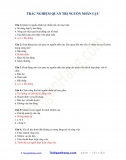TABLE OF CONTENTS
ACKNOWLEDGEMENTS........................................................................................................... iii
DISCLAIMER ................................................................................................................................ iv
LIST OF FIGURES ........................................................................................................................ ix
LIST OF TABLES........................................................................................................................... x
LIST OF ACRONYMS .................................................................................................................. xi
ABSTRACT ................................................................................................................................. xii
Chapter 1: INTRODUCTION ................................................................................................... 1
1.1. Introduction .......................................................................................................................... 1
1.2. Research content ................................................................................................................... 1
1.3. Research aims ....................................................................................................................... 2
1.4. Overall experimental design of the project ........................................................................... 2
1.5. Research hypotheses ............................................................................................................. 2
Chapter 2: LITERATURE REVIEW.......................................................................................... 4
2.1. Overview of turmeric and turmeric leaves ........................................................................... 4
2.1.1. Origin ............................................................................................................................ 4
2.1.2. Characteristic ................................................................................................................. 4
2.1.3. Chemical composition and application ......................................................................... 8
2.1.3.1. Chemical composition ........................................................................................... 8
2.1.3.2. Nutritional value .................................................................................................. 10
2.1.3.3. Application ........................................................................................................... 10
2.2. Overview of essential oils................................................................................................... 12
2.2.1. Definition .................................................................................................................... 12
2.2.2. Origin and development of essential oils .................................................................... 13
2.2.3. Physical properties and chemical compositions of essential oils ................................ 13
2.2.3.1. Physical properties ............................................................................................... 14
2.2.3.2. Chemical compositions ........................................................................................ 14
2.2.4. Applications of essential oils ....................................................................................... 17
2.3. Techniques for recovering essential oils ............................................................................ 18
2.3.1. Distillation methods .................................................................................................... 18
2.3.1.1. Hydro-distillation (HD) ....................................................................................... 18
2.3.1.2. Water-steam distillation ....................................................................................... 18
2.3.1.3. Steam distillation (SD) ......................................................................................... 19
2.3.2. Solvent extraction ........................................................................................................ 19
2.3.3. Cold pressing ............................................................................................................... 20
vi
2.3.4. Soxhlet extraction ........................................................................................................ 21
2.3.5. New methods in essential oil extraction ...................................................................... 22
2.3.5.1. Microwave-Assisted Hydro-distillation (MAHD) ............................................... 22
2.3.5.2. Ultrasound-Assisted extraction (UAE) ................................................................ 23
2.3.5.3. Supercritical Fluid Extraction (SFE) ................................................................... 23
2.4.2. The main influencing factors in steam distillation ...................................................... 25
2.4.2.1. Diffusion .............................................................................................................. 25
2.4.2.2. Hydrolysis ............................................................................................................ 26
2.4.2.3. Temperature ......................................................................................................... 26
2.4.2.4. Advantages and disadvantages ............................................................................ 26
2.5. Introduction to gas chromatography with mass spectrometry (GC/MS) ............................ 27
2.5.1. Gas Chromatography (GC) ......................................................................................... 27
2.5.2. Mass Spectrometry (MS) ............................................................................................ 28
2.5.3. Gas chromatography with mass spectrometry (GC–MS) ........................................... 28
2.6. A brief overview of pathogenic microorganisms in the research ....................................... 28
2.6.1. Staphylococcus aureus ................................................................................................ 28
2.6.2. Escherichia coli ........................................................................................................... 29
2.7. Research situation of turmeric leaf essential oil ................................................................. 31
2.7.1. Domestic studies on turmeric leaf essential oil ........................................................... 31
2.7.2. Overseas studies on turmeric leaf essential oil ............................................................ 31
2.7.2.1. Constituents of the Leaf Oil of Curcuma longa L. from Uttaranchal .................. 31
2.7.2.2. Chemical composition and antifungal activity of oil extracted from turmeric
leaves (Curcuma longa L.) ..................................................................................................... 31
Chapter 3: RESEARCH MATERIALS AND METHODS ................................................... 33
3.1. Plant material ...................................................................................................................... 33
3.2. Tools, equipment, chemical substances .............................................................................. 33
3.2.1. Tools, equipment ......................................................................................................... 33
3.2.2. Chemical substances ................................................................................................... 33
3.3. Research diagram ............................................................................................................... 34
3.4. Research methods ............................................................................................................... 34
3.4.1. Experimental design .................................................................................................... 34
3.4.2. Analytical methods ...................................................................................................... 36
3.4.2.1. Determination of total essential oil content in the material ................................. 36
3.4.2.2. Analysis of physicochemical quality ................................................................... 37
3.4.2.3. Analysis of chemical composition ....................................................................... 39
3.4.2.4. Sensory evaluation ............................................................................................... 39
3.4.2.5. Analysis of antimicrobial activity ........................................................................ 40


 ThiNganHang Sách - Tài liệu thi tuyển
ThiNganHang Sách - Tài liệu thi tuyển









